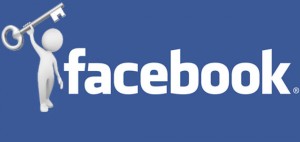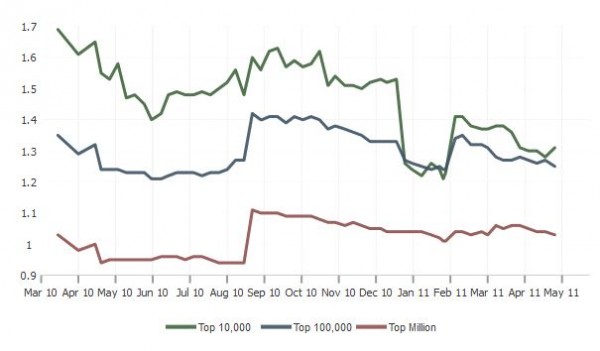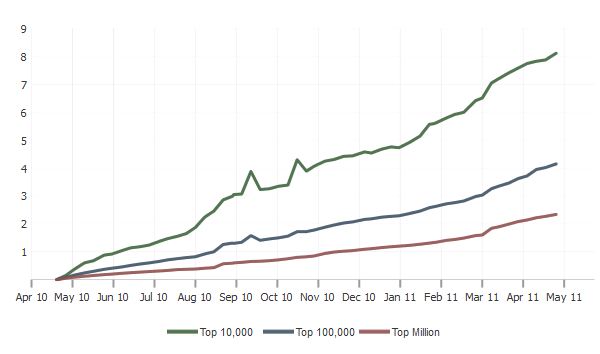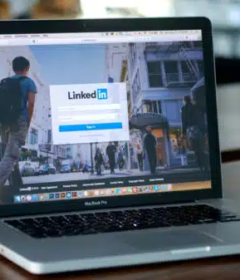Has Facebook Become The Master Key To Unlocking The Web?

When Facebook rolled out its Send button last week, I laughed. I even mocked on Twitter that Facebook wouldn’t be happy until our pages were full of buttons. But the Send button, as well as integrating other aspects of Facebook into websites, does make a lot of sense. In fact, it’s beginning to make so […]
So Many Doors, So Many Keys
 100vw, 128px” data-lazy-src=”https://searchengineland.com/figz/wp-content/seloads/2011/05/openid.jpg” /></a>For as long as I can remember on the web, there’s been talk about what a pain it is to remember a million passwords to sign in to a million different sites. Wouldn’t it be better if we had one universal “key” to open all those web doors? And wasn’t that was <a href=) OpenID was supposed to be about?
OpenID was supposed to be about?
Heck, Facebook even seemed to be jumping on the OpenID bandwagon back in 2009, when it said that new users could register for Facebook using Gmail accounts, which double as OpenIDs. From Facebook’s blog post at the time:
Now, users can register for Facebook using their Gmail accounts. This is a quicker, more streamlined way for new users to register for the site, find their friends, and start exploring.
 100vw, 254px” data-lazy-src=”https://searchengineland.com/figz/wp-content/seloads/2011/05/facebook-signup.jpg” /></a>But in writing this piece, when I looked at the Facebook sign-up screen (over there on the right), I saw no option that seemed to allow this. You want a new Facebook account? You open an account directly through Facebook, seems to be the case.</p>
<p>(After you’ve created a Facebook account, <a href=) you can link your Google account from the Linked Accounts area in Facebook so that if you’re logged into Google, or another OpenID account, you’ll go right into Facebook. I tested it, and it does work — sometimes. But that’s not the same as new users opening Facebook accounts with another company’s login system).
you can link your Google account from the Linked Accounts area in Facebook so that if you’re logged into Google, or another OpenID account, you’ll go right into Facebook. I tested it, and it does work — sometimes. But that’s not the same as new users opening Facebook accounts with another company’s login system).
The Facebook Master Key
Opening a Facebook account with another provider’s login is really a side issue, however. To me, the real story is how your Facebook account “key” increasingly lets you open many non-Facebook doors.
 100vw, 235px” data-lazy-src=”https://searchengineland.com/figz/wp-content/seloads/2011/05/facebook_like_button_big.jpg” /></a><a href=) Facebook Like buttons are everywhere, it seems. I’ll share some stats on these in a bit. Want to recommend a story to friends? You probably have a Facebook account, and pushing a Like button on a website is a pretty easy way to do it.
Facebook Like buttons are everywhere, it seems. I’ll share some stats on these in a bit. Want to recommend a story to friends? You probably have a Facebook account, and pushing a Like button on a website is a pretty easy way to do it.
Want to comment on a website? If the site doesn’t want a ton of garbage or spam, it’ll require some type of registration. The new Facebook Comments system that rolled out in March makes this easy, with the added promise of more Facebook-related traffic.
Want to email a story to someone? The new Facebook Send button, that makes it easy:
 100vw, 409px” data-lazy-src=”https://searchengineland.com/figz/wp-content/seloads/2011/05/facebook-send.png” /></a></p>
<p>Yes, the final frontier, the ages-old “email story to a friend” button has now been conquered by Facebook.</p>
<h2>The Key With A Bribe</h2>
<p>It’s not that visitors were unable to do these things (and more) before Facebook’s <a href=) Social Plugins launched last year.
Social Plugins launched last year.
For example, ShareThis makes it easy to email stories plus have Like-style buttons for Facebook, Twitter and many other social sharing sites. Disqus lets you have comments that support logging in not only from Facebook but also from smaller providers you may have heard of, like Twitter and Google.
But Facebook’s tools offer an added incentive for publishers. “Socialize” your site with them, and you’ll make it more visible within the walls of the 600 million-strong garden of the Facebookweb.
What’s the competition to this? Sure, my Google or Yahoo account might let me comment on a site if it’s using Disquis or has implemented some OpenID-compliant system? But I get no added benefit in terms of Google or Yahoo traffic by doing so.
How Many Doors Does Facebook Open?
When the Facebook Like button was announced just over a year ago, Facebook CEO Mark Zuckerberg talked about there being one billion Likes that would happen within 24 hours. I took this to mean one billion Like buttons would appear. If so, how many are there now?
In working on this piece, Facebook clarified that Zuckerberg was talking about number of Like “impressions” — that Like buttons would be shown 1 billion times over that period, not that there were 1 billion different URLs each with Like buttons.
OK, how many pages with Like buttons are there? “We do not have the total number of Like buttons available to share,” Facebook emailed me.
Facebook did say that “millions” of sites in general carry the buttons. Since websites often have hundreds or thousands of pages, the number of actual buttons is well beyond this. For example, Search Engine Land is a single site with over 15,000 individual pages, each of which carries a Facebook Like button.
While Facebook wouldn’t give a specific figure, it seems likely there are about 2.5 million sites with Like buttons, according to other data points that Facebook has given. In fact, using some of those points, I feel comfortable sketching out a rough graph of Like button growth:
 100vw, 600px” data-lazy-src=”https://searchengineland.com/figz/wp-content/seloads/2011/05/facebook-like-buttons-600×434.jpg” /></a>The chart has two lines. The continuous red one is a polynomial trend line that Excel generated for me, which best fit the hard data points I had. It may or may not fit the actual trend, of course.</p>
<p>The blue line (along with two blue diamonds further back from it) shows actual data points we have from Facebook. Those in bold are total numbers for the particular months, in particular:</p>
<blockquote><p><strong>April 2010:</strong> On April 28, <a href=) Facebook announced that 50,000 sites had implemented its new social plugins since they’d been announced a week earlier. The plugins include more than the Like button, of course. I’ll come back to this. But I’ve taken that 50,000 figure for the 4/10 figure shown on the chart — total number of implementations at the end of April 2010.
Facebook announced that 50,000 sites had implemented its new social plugins since they’d been announced a week earlier. The plugins include more than the Like button, of course. I’ll come back to this. But I’ve taken that 50,000 figure for the 4/10 figure shown on the chart — total number of implementations at the end of April 2010.
July 2010: The Wall Street Journal reported that as of July 2010, 350,000 sites had added plugins, a figure apparently from Facebook.
April 2011: Facebook’s stats page currently reports more than 2.5 million sites have “integrated” with Facebook.
Those numbers in italics are derived from growth figures Facebook has given out:
October 2010: Facebook COO Sheryl Sandberg talked about 10,000 “integrations” happening per day.
April 2011: For the Like button’s one year birthday, Facebook said that more than 10,000 sites add the Like button each day
May 2011: The aforementioned Facebook’s stats page talks about 10,000 new social plugin integrations per day, on average, since April 2010.
OK, do “integrations” equal sites with Facebook Like buttons? Pretty much, yes. I asked Facebook if the 10,000 figure of “integrations” that Sandberg talked about in October was the same statistic as mentioned in its birthday post about Like buttons. Yes, I was told, it was the same statistic.
I also reconfirmed the 350,000 figure from July. “Yes, within 4 months of launch, more than 350,000 websites had added the Like button,” I was told.
That means if we know there are 2,500,000 Facebook “integrations” now — a term used interchangeably with Like buttons — we can then work backward using those 10,000 integrations that are added per day (300,000 per month) figures. Just subtract those integrations each month going backward from 2,500,000.
I did this through October, which was the first time the 10,000 per day growth figure came out. The trend produced won’t match exactly what’s happened, but it’s the best guess I can make working from Facebook’s own numbers.
Can Others Compete? Sure, But…
So Facebook “unlocks” 2.5 million websites, and the number is going up all the time. Can anyone compete? Sure. No. Maybe. It all depends.
Sure, anyone should be able to reach the number — 2.5 million websites is practically nothing. Netcraft currently estimates there are 325 million websites out there. That means Facebook is integrated into less than 1 percent of them. The market is wide open!
Of course, it’s not just about having the biggest numbers. That’s sort of like the tiresome stats about which platform has more mobile apps, Apple’s iOS or Google’s Android. Who cares if one has 10,000 more apps than the other, if those 10,000 aren’t that useful? You care about the apps that matter.
That’s why on Facebook’s stat page, you see this:
More than 2.5 million websites have integrated with Facebook, including over 80 of comScore’s U.S. Top 100 websites and over half of comScore’s Global Top 100 websites
I’ve bolded the key part, about Likes being so heavily used by top sites. But below are two other stats that reflect this, too. Both are from BuiltWith Trends, which scans the top million sites as reported by Quantcast to see widgets and other plugins that are most used.
The first is for JavaScript libraries:
 100vw, 600px” data-lazy-src=”https://searchengineland.com/figz/wp-content/seloads/2011/05/javascript-libraries-600×348.jpg” /></a></p>
<p>As you can see, <a href=) Facebook For Websites — which seems to cover any Facebook Social Plugins including Likes — is the second most popular library used.
Facebook For Websites — which seems to cover any Facebook Social Plugins including Likes — is the second most popular library used.
It has also grown steadily over the past year (lines below show percentage of sites in the top 10,000, 100,000 and million using the library:
 100vw, 598px” data-lazy-src=”https://searchengineland.com/figz/wp-content/seloads/2011/05/facebook-for-websites-growth.jpg” /></a></p>
<p><a href=) The second stat is for “Widget Distribution,” which seems to cover individual implementation of things covered generally by Facebook For Websites (or widgets from other sites). Here, the Facebook Like button leads the pack:
The second stat is for “Widget Distribution,” which seems to cover individual implementation of things covered generally by Facebook For Websites (or widgets from other sites). Here, the Facebook Like button leads the pack:
They’ll Need A Good Bribe
Can a challenger match Facebook’s getting into the most popular sites on the web?
A challenger isn’t going to do it, not with the visibility that Facebook gets, without offering a bribe. In my view, the days of sites just slapping buttons all over the place are coming to an end.
We’ve been down that road with Digg. Digg buttons, as best I can tell from what I’ve seen and heard over the years, had virtually no impact on the vast majority of sites that actually did well in Digg.
Instead, Digg was ruled by what a relatively small number of influencers liked. And now, who cares about Digg? The buttons are going:
 Facebook is different. Its buttons can help you build your own fan base on Facebook, which in turn can drive traffic back to your site. Any new player coming along, hoping to cash in on the button craze of the past, is going to be sorely disappointed unless they come to the table with a big bribe.
Facebook is different. Its buttons can help you build your own fan base on Facebook, which in turn can drive traffic back to your site. Any new player coming along, hoping to cash in on the button craze of the past, is going to be sorely disappointed unless they come to the table with a big bribe.
The Tweet Bribe
Who are the leading candidates to bribe sites successfully? Twitter’s already doing well. The tweet button it rolled out last August has been growing in usage:
It’s easy to know why. The button makes it easy for publishers to have their visitors share a story on Twitter. Twitter can drive much traffic, so it’s worth the visibility exchange. It’s also worth using Twitter as a registration tool, because so many people use Twitter.
(Personally, if a site offers me a choice between using my Twitter or Facebook login, I go with Twitter because it’s simple. I don’t worry that by using my Twitter “key” that I’ve somehow let people into my “home” where I might need to lock a bunch of other doors. With Facebook, I never quite feel like I know what a site might do with my data. The disclosures of using Facebook to sign-up for Groupon freaked me out a bit, for example.)
But Twitter has weaknesses. Facebook’s tools allow for sites to show recommended content, comments and much more. Twitter’s tools lack some of this. Our technical director Michelle Robbins tells me it was much harder for us to show the most tweeted stories from our site (as we do in our sidebar) than it was to use Facebook’s recommendation widget.
Also, as best I can tell, Twitter lacks anything like Facebook’s “Facepile” box that I know first hand can build a fan base. Sure, I can show tweets from our site through a widget. But showing the faces of real people who follow us would be nice. I can haz pls, Twitter?
Google’s Lack Of Bribe
Google, of course, looms large. It already has Google Friend Connect, launched in May 2008 and opened to everyone in December 2008. But that doesn’t seem to have taken off in the way that Facebook’s tools have. I rarely seem to encounter it on sites compared to Facebook’s tools. The BuildWith stats also reflect low take-up:
 This is probably because it seems unclear what a site gains from giving a Google Friend Connect widget much visibility.
This is probably because it seems unclear what a site gains from giving a Google Friend Connect widget much visibility.
Yes, it can be a login tool, which in turn can power gadgets like commenting, polls and ratings. But what’s the traffic bribe?
Out of curiosity, we put up a Google Friend Connect members widget yesterday. You’ll find it in our sidebar. If you do join the four people we have signed up through it so far, at the time I wrote this, there won’t be anything else for you to do. None of the Google Friend Connect widgets are compelling enough for us to use.
+1 = The Google Key?
This is where Google +1 has potential. I have absolutely no doubt that when Google finally rolls the promised +1 button for web sites, publishers will snap them up. Fast. I wouldn’t be surprised if Google starts quoting figures that show there are more sites using +1 buttons that Like buttons.
Google’s a huge, proven traffic driver, and long has been. If Google +1 will help increase traffic, publishers will give it space.
But will people, rather than just publishers, use it? What’s the bribe for visitors? Twitter’s button makes it easy to share to friends and followers on Twitter. Facebook’s buttons make it easy to do the same on Facebook.
Google +1 promises to maybe improve my search results and to make a list of things I like if my friends choose to go to my profile page on a regular basis to check — and only if I’ve opened up my +1 tab.
That’s complicated and not particularly compelling. I think Google’s going to need to up the offer for visitors, to get the clicking started. If it doesn’t, it’ll only win half the battle. It’ll get space on sites, but it won’t get the valuable social sharing data it wants.
Reality Check
In the end, to answer the question of my headline, I don’t really think that Facebook has become that universal key to the web. But I do see Facebook’s tools — and its login — being more and more integrated into the sites I encounter. I do wonder if we’re hitting a tipping point in the short term. In the long term, things always change.
For its part, when I asked Facebook’s chief technical officer Bret Taylor what his take was on the idea that Facebook has “won” the login wars, he immediately drew away from there being some type of battle going on.
“I really don’t think of these things as a zero sum game to be honest,” Taylor said. “We’re definitely tying to make it easy for people to share on Facebook wherever they are, but the information that flows through Facebook also benefits others.”
Taylor also stressed that both publishers and Facebook users have control over what they want to send in and get out of Facebook through these tools. “I think that’s really important,” he said.
Coming up next — I’ve talked about the bribe. But does it really pay off? That’ll be my next story, later this week, with some stats from around the web plus a close-up look at a day in the life of Search Engine Land on Facebook.

 100vw, 600px” data-lazy-src=”https://searchengineland.com/figz/wp-content/seloads/2011/05/widget-distribution-600×334.jpg” /></a></p>
<p>The growth story over the past year is the same:</p>
<p><a href=)



